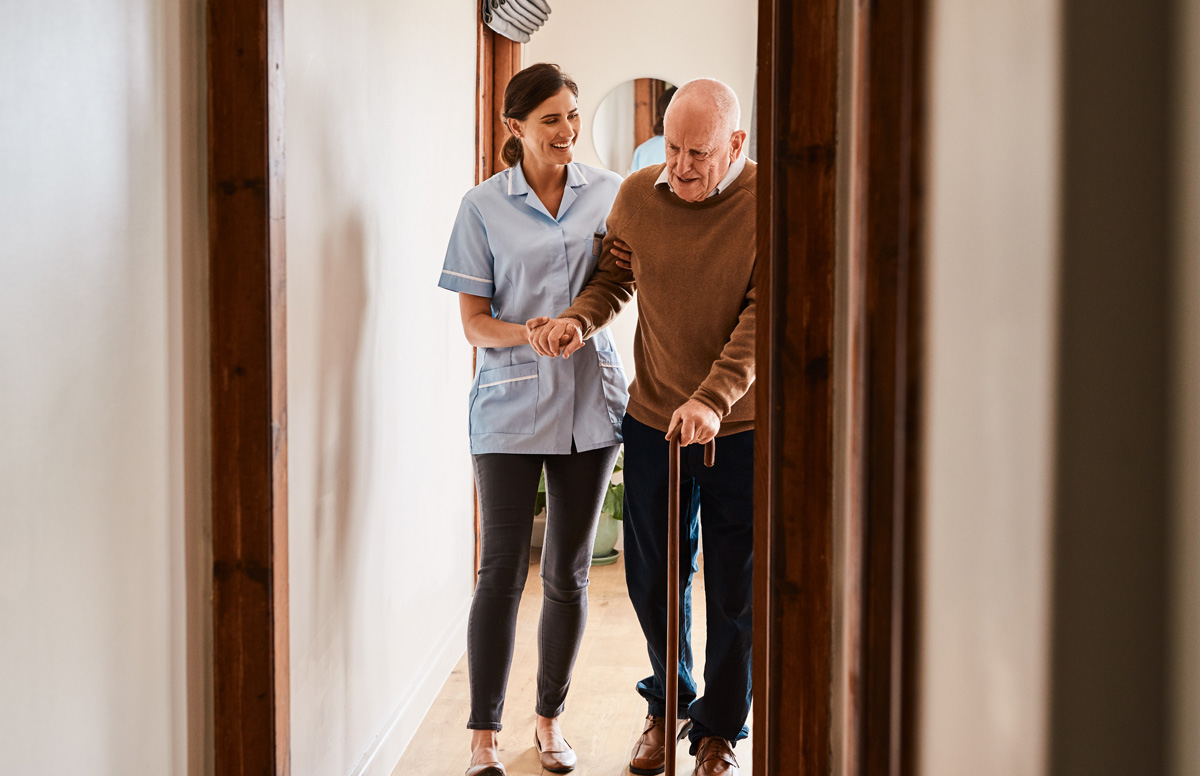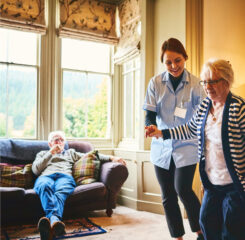Around the globe, researchers are using new technologies to address a long-time challenge: preventing falls among older adults. These innovative minds are looking at new ways to use virtual reality (VR), build agile robots, and apply machine learning to reduce fall risk—keeping older adults healthy and independent.
With solutions such as these emerging, aging services providers will soon have even more fall-prevention tools at their disposal.
Combining Treadmill Walking and Virtual Reality
GaitBetter, a leader in virtual reality-based rehabilitation based in Rockville, MD, recently launched a first-of-its-kind community wellness program to help older adults reduce falls, staying mobile and confident. The gaitACTIVE program combines training on GaitBetter’s patented motor-cognitive treadmill system with VR environments that simulate everyday walking scenarios. It offers a fresh take by addressing the cognitive aspects of walking—like multitasking, motor planning, attention and decision-making—rather than focusing on muscle strength or balance.
Trained facilitators guide participants through a fun, engaging curriculum designed to improve gait, dynamic balance, and relevant cognitive skills. The program can be delivered in community centers, continuing care retirement communities, senior wellness centers, and outpatient clinics.
VR Reduces Falls-Related Anxiety and Improves Stability
Immersive VR technology is being studied for its potential to reduce falls. Researchers from two Virginia schools, George Mason University (GMU) School of Kinesiology and Old Dominion University’s Ellmer College of Health Sciences, are pursuing their vision to use “affordable VR technology to outperform traditional diagnostics, therapeutics, and pharmaceutical approaches in fall prevention,” according to a GMU news release.
The studies look at how immersive VR can detect cognitive-motor function related to fall risk, reduce anxiety about falling, and ultimately improve walking ability.
Specifically, the immersive VR studies found that older adults who felt anxious about falling had more difficulty walking. However, over time, immersive VR experiences lowered anxiety and improved stability even when older adults were not wearing VR headsets. As a result, researchers concluded that using immersive VR could be a clinical intervention to reduce fall risk while walking.
Robot Stops Falls with First-of-its-Kind Harness-Free Design
What is thought to be the first robot to stop falls without harnesses or other wearable devices has been developed by engineers at the Massachusetts Institute of Technology (MIT), says an article in AT Today. Instead, the Elderly Bodily Assistance Robot (E-BAR) offers assistive handlebars.
E-BAR follows an older adult, senses any impending fall, and inflates airbags along the person’s sides to catch them, effectively and gently. Older adults can also grab the handlebars for help entering and exiting a bathtub, sitting on and rising from a toilet, getting up from the floor, reaching down to pick up low items, and support while walking.
Designed for use at home or in care facilities, E-BAR provides stability without harnesses, to meet older adults’ wishes. Future planned improvements include automating E-BAR so that it can autonomously follow and assist older adults, as well as adjusting the design so that it is easier to use in tight spaces.
Real-Time Internet of Things (IoT) and Computer Vision-Based System Detects Falls
In another recent innovation, researchers in Bangladesh are pioneering the use of computer vision via video streams, plus detection logic, to determine if an older adult has fallen. ElderFallGuard is an IoT solution that uses machine learning to identify prone human poses that indicate falls. If it recognizes these positions and the person has been still for over three seconds, the system alerts caregivers via Telegram.
Testing revealed high accuracy, precision, recall, and F1-score (a machine learning metric for evaluating a model’s accuracy), wrote the study’s authors, from the Bangladesh University of Engineering Technology and the Hajee Mohammad Danesh Science and Technology University.

 Shutdown Week Three: Impact of Ongoing Closure on Affordable Housing
Shutdown Week Three: Impact of Ongoing Closure on Affordable Housing CMS Debuts Models: ACCESS, ELEVATE and LEAD
CMS Debuts Models: ACCESS, ELEVATE and LEAD


